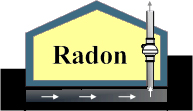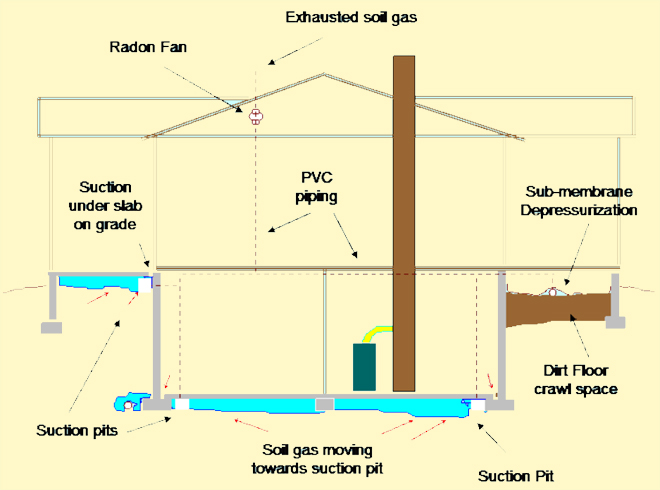 |
 |
Bill Brodhead WPB Enterprises Inc
Radon & Vapor Intrusion |
 |
 |
|
Bill Brodhead WPB Enterprises Inc.
Radon & Vapor Intrusion |
 |
 |
|
 |
Radon & Vapor Intrusion Mitigation System Design
Active Soil Depressurization (ASD) for: |
 |
|
WPB Home page Other Info See WPB Commercial jobs System Pictures Reducing Basement Moisture Radon Fan Performance Radon in Water - FAQ & info page WPB Home Page List of all WPB-radon pages |
Radon & Vapor Intrusion
|
 |
|
WPB Home page |
 |
|
Elevated radon levels, TCE or VOC's are primarily due to the infiltration of soil gas entering the house from cracks in the concrete slab or exposed soil. The flow of soil gas into the house is usually being driven by a slight negative pressure above the slab (created by the house) that draws soil gas into the home. Most radon mitigation systems use Active Soil Depressurization (ASD) to reverse the normal flow of soil gas. A fan and piping is used to draw air out from under the concrete slab(s) or from under a membrane. The withdrawal of air causes the sub-slab or sub-membrane area to be a lower pressure than the air in the house. This lower or negative pressure prevents the soil gas from entering the home. The system is referred to as a Sub-Slab Depressurization (SSD) system or a Sub-Membrane Depressurization (SMD) system. At each suction location a 5" hole is cored through the slab and the gravel and soil under the slab are removed to create a suction pit. The PVC radon piping is inserted into the slab and sealed so that it is water and air tight.
To see pictures of vapor intrusion / radon systems go to: Military Systems photos The Radon Mitigation Standards of Pennsylvania defines how basic components of the radon mitigation system must be installed. WPB abides by all code requirements. Some of the code requirements are the following. Radon fan cannot be installed inside or below the living space of the home. The fan must be outside or in the attic. The radon exhaust must be above the roof shingles and two feet above any window within ten feet of the exhaust. All perimeter cracks and any other significant cracks in the slab must be sealed. A basement must have a floor drain if the basement slab had a means for draining water before the system was installed. After a radon mitigation system is installed and running, all natural draft combustion appliances must be tested to check if the chimney backdrafts when all house exhaust fans are operating. Piping routed into or out of a fire rated garage wall or ceiling must have use fire collars. |
 |
|
Get a copy of the actual Pennsylvania Radon Mitigation Standards RMS. Get a copy of the latest version of AARST ASD RMS |
 |
 |
|
Elevated radon levels, TCE or VOC's are primarily due to the infiltration of soil gas entering the house from cracks in the concrete slab or exposed soil. The flow of soil gas into the house is usually being driven by a slight negative pressure above the slab (created by the house) that draws soil gas into the home. Most radon mitigation systems use Active Soil Depressurization (ASD) to reverse the normal flow of soil gas. A fan and piping is used to draw air out from under the concrete slab(s) or from under a membrane. The withdrawal of air causes the sub-slab or sub-membrane area to be a lower pressure than the air in the house. This lower or negative pressure prevents the soil gas from entering the home. The system is referred to as a Sub-Slab Depressurization (SSD) system or a Sub-Membrane Depressurization (SMD) system. At each suction location a 5" hole is cored through the slab and the gravel and soil under the slab are removed to create a suction pit. The PVC radon piping is inserted into the slab and sealed so that it is water and air tight.
To see pictures of vapor intrusion / radon systems go to: Military Systems photos The Radon Mitigation Standards of Pennsylvania defines how basic components of the radon mitigation system must be installed. WPB abides by all code requirements. Some of the code requirements are the following. Radon fan cannot be installed inside or below the living space of the home. The fan must be outside or in the attic. The radon exhaust must be above the roof shingles and two feet above any window within ten feet of the exhaust. All perimeter cracks and any other significant cracks in the slab must be sealed. A basement must have a floor drain if the basement slab had a means for draining water before the system was installed. After a radon mitigation system is installed and running, all natural draft combustion appliances must be tested to check if the chimney backdrafts when all house exhaust fans are operating. Piping routed into or out of a fire rated garage wall or ceiling must have use fire collars. |
 |
|
Get a copy of the actual Pennsylvania Radon Mitigation Standards RMS. Get a copy of the latest version of AARST ASD RMS |
 |
